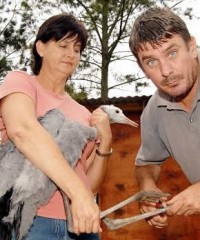Blue Cranes Released
Thursday, 25th February 2010
Weekend Post - Guy Rogers
Four members of South Africa’s national bird species, rescued from illegal captivity and rehabilitated in Port Elizabeth, were released into the wild yesterday.
Blue cranes are – along with the Cape parrot – among the country’s indigenous birds most heavily targeted by smugglers.
Two of the rehabilitated blue cranes were saved from the pot by a trucker who spotted them in the hands of a group of children on the side of the road in the Murraysberg area.
They were passed on to Port Elizabeth wildlife rehabilitation group Wildline and shortly afterwards the organisation received two other birds seized by police from a Kragga Kamma property.
The Kragga Kamma birds comprise a juvenile and a mature female with a broken wing that had received no veterinary attention and was just “taped up with masking tape”, Wildline chairman Arnold Slabbert said.
Even after rehabilitation, the female will never be able to fly again, “but the option is either to put her down or to let her take her chances in the wild,” he said.
“The principle is that after rehabilitation a wild animal should always be returned to the wild unless there is a very sound reason not to. In this case, blue cranes don’t need to be able to fly in order to feed, and she will also be able to breed and socialise.”
The birds were ringed at the Wildline holding camp in Sherwood on Tuesday afternoon to track the success of the rehabilitation programme.
Blue cranes feed on grains, seeds and insects and there is an abundance of this food on the farm near Hanover between Graaff-Reinet and Middelburg in the Karoo where the birds were released yesterday.
Speaking to The Herald from the site, Slabbert said the birds would be protected on the farm. The resident flock of 30-40 juveniles on the farm would probably accept the leadership of the adult female.
The farm was about 350km from Port Elizabeth, so Wildline had spent substantial funds on fuel besides the cost of feeding and treating the birds over the past month, he admitted.
“But it’s important. This is a threatened species and it’s worth putting in the effort.” Bradley Gibbons, of the Endangered Wildlife Trust’s Karoo Crane Conservation Project, who participated in the release, said there were only 25000 blue cranes left. Almost all of them were in South Africa, with just a few in Namibia and Botswana. This is the smallest range of any of the 15 crane species around the world.
The species is threatened because of this restricted range as well as poisoning and, most importantly, power line collisions. The Karoo project has nevertheless established a good relationship with Eskom and thousands of “flappers” have been installed on the lines to make them more visible to the birds.
The Karoo population, comprising 6000 to 8000 birds, was the largest blue crane population living in natural veld as opposed to agricultural land in the Western Cape where most of the other birds were, Gibbons explained.
He said he believed the newcomers would integrate well. “It’s the perfect habitat and they can make some friends. They have a chance once again to be wild and free.”
